Showing 1–12 of 17 results
- Price range: € 16,00 through € 109,00 Incl. VATSelect options This product has multiple variants. The options may be chosen on the product page
- € 20,40 Incl. VATSelect options This product has multiple variants. The options may be chosen on the product page
- Price range: € 13,50 through € 83,25 Incl. VATSelect options This product has multiple variants. The options may be chosen on the product page
- Price range: € 9,35 through € 95,85 Incl. VATSelect options This product has multiple variants. The options may be chosen on the product page
- Price range: € 16,95 through € 115,00 Incl. VATSelect options This product has multiple variants. The options may be chosen on the product page
- Price range: € 11,95 through € 81,35 Incl. VATSelect options This product has multiple variants. The options may be chosen on the product page
- Price range: € 36,00 through € 242,00 Incl. VATSelect options This product has multiple variants. The options may be chosen on the product page
- Price range: € 19,95 through € 129,95 Incl. VATSelect options This product has multiple variants. The options may be chosen on the product page
- Price range: € 14,75 through € 95,85 Incl. VATSelect options This product has multiple variants. The options may be chosen on the product page
- Price range: € 15,50 through € 98,50 Incl. VATSelect options This product has multiple variants. The options may be chosen on the product page
- Price range: € 174,00 through € 327,00 Incl. VATSelect options This product has multiple variants. The options may be chosen on the product page
- Price range: € 9,95 through € 78,75 Incl. VATSelect options This product has multiple variants. The options may be chosen on the product page
Showing 1–12 of 17 results
Banisteriopsis caapi
Walking around the community gardens and forest areas of countries of the Amazon, you’d often spot a woody, braided vine climbing and enwrapping its neighboring trees. Seemingly unassuming, this revered liana, known to botany as Banisteriopsis caapi, holds the key to one of the most potent entheogenic concoctions in the world — ayahuasca.
In this article, we will delve into the intricate web of ancient and modern wisdom surrounding the use of this powerful plant. We will explore its origins, diverse applications throughout history, therapeutic potential, and the profound impact it has had on spiritual seekers and healers, both in its native habitat and across the globe.
What Is Banisteriopsis caapi?
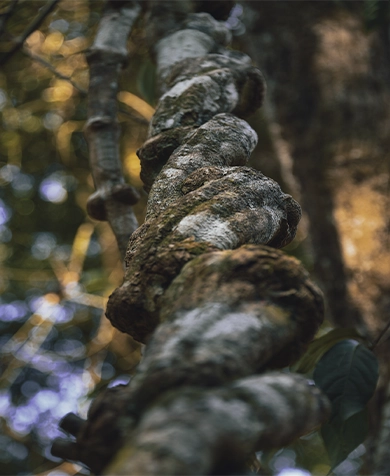 Banisteriopsis caapi, often referred to as caapi, yagé, or aya waska (the ‘Vine of the Soul’ in Quechuan languages), is a psychoactive liana indigenous to the Peruvian, Ecuadorian, Colombian, Brazilian, and Bolivian Amazon. It grows abundantly throughout its range, using other sturdy plants as support; zoom far enough out and it’s almost as if it connects the flora of the entire rainforest into a vast, breathing network.
Banisteriopsis caapi, often referred to as caapi, yagé, or aya waska (the ‘Vine of the Soul’ in Quechuan languages), is a psychoactive liana indigenous to the Peruvian, Ecuadorian, Colombian, Brazilian, and Bolivian Amazon. It grows abundantly throughout its range, using other sturdy plants as support; zoom far enough out and it’s almost as if it connects the flora of the entire rainforest into a vast, breathing network.
Aside from being deeply woven into the vibrant biome of the Amazon, the Banisteriopsis caapi vine also makes up the fundamentals of the cultural tapestry and magical and medicinal practices of many of the basin’s indigenous peoples. It is a key component in the preparation of ayahuasca, a sacred entheogenic brew used for spiritual and healing purposes by various Amazonian cultures since ancient times.
The Banisteriopsis caapi vine is considered sacred in indigenous lore — its powerful effects and the guidance that can be received by communing with the vine’s spirit have earned it the Master Plant Teacher status. In order to form a strong bond with it, Amazonian shamans usually go through months or years of communing with the brew in solitude, while surviving on a basic diet.
How is Banisteriopsis caapi Prepared?
Depending on the intention behind preparing ayahuasca, it can be made by brewing the Banisteriopsis caapi vine by itself or by brewing it along with the leaves of other plants, namely Psychotria viridis (chacruna) or Diplopterys cabrerana (chaliponga).
With the increasing interest of Western seekers over the last few decades, the B caapi vine bark essence is also becoming increasingly available in the form of a resin extract or tincture, eliminating the need for a long brewing process and allowing for more convenient consumption.
 Caapi-only Brews
Caapi-only Brews
While a caapi-only brew has some psychoactive effects, those who don’t have a strong connection with the spirit of the vine might not get much from this recipe other than some light visions, nausea, purging, and a variety of bodily sensations.
Still, with its complex chemistry and, according to indigenous belief, powerful spirit, a brew made from the Banisteriopsis caapi vine by itself imparts deep healing on the drinker, whether they can detect it or not.
Caapi + DMT Brews
On the other hand, a brew made with both the vine and the DMT admixture can occasion an immensely psychedelic experience, catalyzing otherworldly visionary journeys, profound life insights, intelligent interactions with sentient entities, and potent emotional breakthroughs.
In indigenous Amazonian traditions, the visionary effects of the brew are believed to originate from the caapi vine itself, with the DMT admixture serving as a catalyst to “illuminate” these visions.
Once they have established a strong bond with the spirit of ayahuasca, seasoned curanderos can experience clear visions not only from drinking caapi-only brews but also just from touching an ayahuasca vine.
How Is Banisteriopsis caapi Used?
Depending on the intention behind preparing ayahuasca, it can be made by brewing the Banisteriopsis caapi vine by itself or by brewing it along with the leaves of Psychotria viridis (chacruna) or Diplopterys cabrerana (chaliponga). With the increasing interest of Western seekers over the last few decades, the B caapi vine bark essence is also becoming increasingly available in the form of a resin extract or tincture, eliminating the need for a long brewing process and allowing for more convenient consumption.
The B caapi vine has played a vital role in the cosmology, medicine, and sorcery of indigenous and mestizo Amazonians for many generations. The sacred brew ayahuasca has been utilized in spiritual rituals, healing practices, and social ceremonies, for gaining insight and guidance, and for waging magical warfare. Traditionally, ayahuasca is consumed by the shaman, who prepares and, per need, administers it to others, either individually, when working with gravely ill patients, or socially, for collective cleansing or marking of/preparing for important community events.
Shamans drink in order to connect with the spirit of the vine and move between this existence and other realities. By communicating with the spirits of the realms beyond, they gain vital guidance which assists them in their diagnostic and healing practices, helps them solve disputes and locate missing people or objects, and steers them in making important decisions for their community.
Since relatively recently in the history of ayahuasca use, the brew is also shared in communal ceremonies for the purposes of psychospiritual healing and growth. These kinds of ceremonies reportedly emerged among marginalized indigenous groups in Iquitos, Peru, and gained immense popularity as Western interest in the brew surged.
In many indigenous Amazonian traditions, shamans often ingest B caapi brews with low amounts or no DMT-containing admixtures. Their deep bond with the ayahuasca Master Plant enables them to cross over to the realms beyond and perform their healings and divinatory rituals, while the intense visual effects of DMT are often considered too distracting to form and maintain a strong connection with Mother Ayahuasca.
If their intentions call for a powerful visionary display or additional effects, shamans may introduce the other plants or any of a number of other medicinal or aromatic admixtures to the brew.
What Are the Active Compounds in Banisteriopsis caapi?
Banisteriopsis caapi contains a group of β-carboline alkaloids known as harmalas, including high levels of harmine, harmaline, and tetrahydroharmine. Each of these compounds has a distinct, mild psychoactive effect and the first two act as reversible inhibitors of monoamine oxidase A enzymes (otherwise known as MAOIs or RIMAs).

Monoamine oxidases are the enzymes responsible for the breakdown of DMT molecules in the human liver and gut. The harmala alkaloids in the B caapi vine counter their effect, preserving the bioavailability of orally ingested DMT. Harmala alkaloids impact the serotonergic system by inhibiting the breakdown of serotonin, which is also a monoamine compound (and a tryptamine, just like DMT). It is believed that their psychoactive effects are the result of this increase of serotonin levels in the central nervous system.
They also inhibit the breakdown of norepinephrine, the hormone and neurotransmitter responsible for our body’s response to stress. It’s likely that this pharmacological process is one of the factors behind the raised heart rate and blood pressure, increased alertness and attention, and altered mood commonly experienced after drinking a B caapi brew.
Banisteriopsis caapi Effects
Consuming pure B caapi brews can induce altered states of consciousness characterized by relaxation and profound insights, making them potential catalysts for alleviating conditions like depression, anxiety, and deep-seated trauma. Caapi use has also been associated with enhanced physical well-being by many plant medicine practitioners who consume the vine on a regular basis.
The harmala alkaloids within B caapi appear to be behind these therapeutic effects, with each of them having distinct medicinal and psychoactive properties. While noting that the experience of ingesting a B caapi vine brew transcends the sum of these individual parts, here are their respective effects:
Harmine reportedly catalyzes a pleasant, dreamy and detached, yet clear-headed state of mind. However, its consumption also typically causes side effects ranging from drowsiness and tremors to gastrointestinal discomfort, nausea, and vomiting. This alkaloid is likely behind the often substantial body loads experienced during ayahuasca journeys.
In research, harmine has shown some noteworthy pharmaceutical potential as an anti-cancer agent and a growth stimulant for bones and pancreatic islet cells (which regulate insulin production). It also reportedly has anti-inflammatory and neuroprotective properties.
Harmaline is said to induce a dreamy, hypnotic, unemotional state similar to the effects of harmine, but more foggy and disorienting. Harmaline is also the most psychoactive of the trio of alkaloids.
It acts as a stimulant of the central nervous system, promotes the conversion of serotonin into melatonin, and has reportedly displayed antiviral properties against HSV-1 and HSV-2.
Tetrahydroharmine (THH), while less explored in scientific research, has garnered plenty of anecdotal praise touting its mood-enhancing, antidepressant, emotionally enjoyable effects accompanied by pleasant bodily tingling and mild closed eye visions.
Interestingly, THH may not contribute as much to monoamine oxidase inhibition and, like harmine, it may be associated with some of the nausea often encountered during ayahuasca experiences.
Because these three harmalas account for much of the somatic and psychoactive effects of ayahuasca, some plant medicine practitioners choose to take things to the next level by extracting specific alkaloids and taking exact dosages of their preferred one(s). This way, they can reduce their body load and nausea, and modulate the emotional and sensory experience during the journey.
Aside from taking high doses of B caapi in order to achieve psychoactive effects, the practice of microdosing Banisteriopsis caapi resin or tincture, or the extracted harmala alkaloids, has been gaining popularity due to its beneficial effects on mental clarity and mood stabilization.
Either as a macro- or a microdose, consumption of Banisteriopsis caapi by itself can serve as an introduction to, or a way to maintain a connection with, the spirit of ayahuasca without going through the intensity of a full-blown ceremony with a DMT-rich brew. It allows those who feel called to drink to better prepare for the journey, while experienced drinkers can reconnect with ayahuasca’s spirit in a more manageable container.
Banisteriopsis caapi Benefits
 An abundance of reports can be found online highlighting the many therapeutic properties of B caapi. Practitioners often tout the vine’s health benefits as well as its ability to promote profound spiritual exploration as a means of catalyzing deep psychological healing and personal evolution.
An abundance of reports can be found online highlighting the many therapeutic properties of B caapi. Practitioners often tout the vine’s health benefits as well as its ability to promote profound spiritual exploration as a means of catalyzing deep psychological healing and personal evolution.
Scientific research has indicated that the harmala alkaloids in B caapi can stimulate neural cell growth, while the polyphenolic compounds found in the vine reportedly possess antioxidant properties. This means that consumption of B caapi may contribute to the protection and development of the brain and help ease symptoms of neurodegenerative disorders such as Parkinson’s disease.
Caapi may also have antidepressant effects, even in cases of treatment-resistant depression. Reductions of symptoms in most studies conducted to date often occur after only a single ayahuasca session, and longitudinal research has shown that a state of remission is typically sustained for many months afterward. The improvement in self-perception B caapi can catalyze may also be helpful for those suffering from eating disorders.
In the realm of addiction treatment, there are preliminary studies suggesting the potential of ayahuasca in reducing alcohol abuse and treating problematic substance use in general. Ayahuasca experiences are thought to raise awareness of the underlying causes of addiction and provide the drinker with deep insight of the consequences of their destructive behavioral patterns and a blueprint toward self-betterment.
Finally, ayahuasca use has been associated with enhanced creative divergent thinking. Even when taken in microdoses, anecdotal reports touting day-to-day creative boosts are abundant. Creativity is a highly idiosyncratic phenomenon, though, so individual results may vary widely.
Combining B caapi or ayahuasca with therapeutic modalities like psychotherapy, bodywork, somatic experiencing, or other forms of energy healing is becoming more and more common in the plant medicine and psychedelic integration communities. These practices can provide support during and after an entheogenic experience, helping individuals implement the insights gained into their personal healing and growth.
Banisteriopsis caapi Side Effects & Risks
B caapi can be safely used by healthy individuals with no prior experience with psychedelics, especially in microdoses. However, if a DMT-rich ayahuasca preparation is involved, it should be consumed only under the guidance of an experienced facilitator, and certain health precautions apply.
Common side effects of B caapi include nausea, vomiting, and increased heart rate and blood pressure, making it unviable for anyone with cardiovascular disorders, hypertension (high blood pressure), or those who are taking blood pressure or other heart medications.
Caapi can also induce mildly altered states of consciousness, which may include symptoms such as drowsiness, emotional detachment, and confusion. This means that activities like driving or operating heavy machinery might be unsafe while under its influence.
While consuming Banisteriopsis caapi by itself does not typically catalyze intense psychoactive effects, taking ayahuasca brewed with a DMT admixture could. These kinds of experiences may acutely trigger psychotic symptoms in individuals predisposed to them. This means that, like with other psychedelics, those with a personal or family history of psychosis are strongly advised to avoid drinking ayahuasca.
As they are MAOIs, the harmala alkaloids in B caapi can interact with certain pharmaceutical substances, particularly other MAOIs or SSRIs (most commonly prescribed antidepressants), potentially leading to serotonin syndrome, which can be a life-threatening condition. Therefore, weaning off antidepressants is advised before taking active doses of B caapi.
The harmala alkaloids can also interact negatively with tyramine, so excessive consumption of tyramine-rich foods and drinks can pose health risks when combined with ayahuasca. Here is a list of items that should be avoided for several days before and after consuming B caapi.
Finally, it’s essential to note that consumption of B caapi is not recommended while pregnant or breastfeeding due to the historical use of harmalas as abortifacients and the lack of scientific understanding of the vine’s effects on lactating women.
What Are the Different Types of Banisteriopsis caapi?
Beyond the many different ritualistic uses of the Banisteriopsis caapi vine, its central role in Amazonian shamanic practices is also evident from the sheer abundance of the kinds of the vine recognized, honored, and used by various indigenous groups.
Depending on local availability, a variety of (sometimes botanically indistinguishable) strains are brewed by shamans to achieve specific desired effects. Some common strains and their purposes include:
- Yellow/Sky/Ray (Amarilla/Cielo/Rayo) ayahuasca: Known for its gentle yet potent healing and visionary properties, this most popular strain is commonly served to those without prior ayahuasca experience.
- White (Blanca/Yura) ayahuasca: This potent strain is often used in magic or sorcery and spiritual defense, for casting or countering spiritual darts (’tsentsak’).
- Red (Colorada/Puka) ayahuasca: This vine might be B caapi’s cousin, Banisteriopsis muricata. It’s strong and primarily used by shamans for diagnosis and healing, while their patients are typically given yellow ayahuasca.
- Black (Negra/Yana) ayahuasca: Known for its intense healing and purgative effects as well as a severe body load, this strain commonly produces visions which may be obscured by a dense black fog. There are different kinds of Black ayahuasca, and they are often associated with witchcraft or brujeria.
- Thunder (Trueno) ayahuasca: Reserved for experienced drinkers, as it can induce intense bodily shaking and violent purging.
- Rattle (Cascabel) ayahuasca: Said to be pure jungle magic, causing extremely powerful effects, and containing strong spirits. Highly revered, rare, and guarded by the shamans, few have gotten a chance to drink from its cup.
- Indian ayahuasca: An ancient and powerful strain harvested exclusively from white sand rainforest areas, not cultivated. It was reportedly widely used by pre-Columbian indigenous peoples.
The names of these vine varieties reflect their intended purposes, effects, the coloration of the plant (flowers or vine when the bark is stripped), or the hue they lend to the visions. Chemically, the distinctions may be due to the different concentrations of the harmala alkaloids, but no one has been able to create a reliable categorization as of yet.
The above list is far from exhaustive, as different indigenous groups categorize vine strains very differently, with some recognizing a few and others dozens of different strains. Some categorizations are based on:
- Masculine or feminine spirit entities – ayahuasca de las mujeres and ayahuasca de los hombres in Ecuador,
- Rainforest and Pachamama (earth goddess) spirits – boa ayahuasca in Peru and Ecuador, yagé tigre and yagé guacamayo (macaw) in Colombia, allpa (earth) ayahuasca in Peru,
- Specific effects or intentions – yagé gente (for communicating with ancestors) and yagé cacería (drunk prior to hunting for receiving visions of and attracting the prey) in Colombia, or
- Physical features of the vine itself – caupuri (knotted) ayahuasca in Ecuador.
Where to Buy Banisteriopsis caapi Legally?
Here at Maya Ethnobotanicals, we offer a range of traditional medicinal plants which have been used by indigenous peoples for a variety of purposes since ancient times.
Our products are organically grown, sustainably harvested, and sourced through fair trade, and we sell them with the intention to promote ethnobotanical enthusiasm throughout the world.
We do not advocate for the use of any of our products in illegal ways, nor do we ship any of our botanical samples to countries where they are illegal.
B caapi vine bark is generally unregulated in most countries as it does not contain scheduled compounds. However, we still advise our customers to inform themselves thoroughly about their local regulations before placing an order.
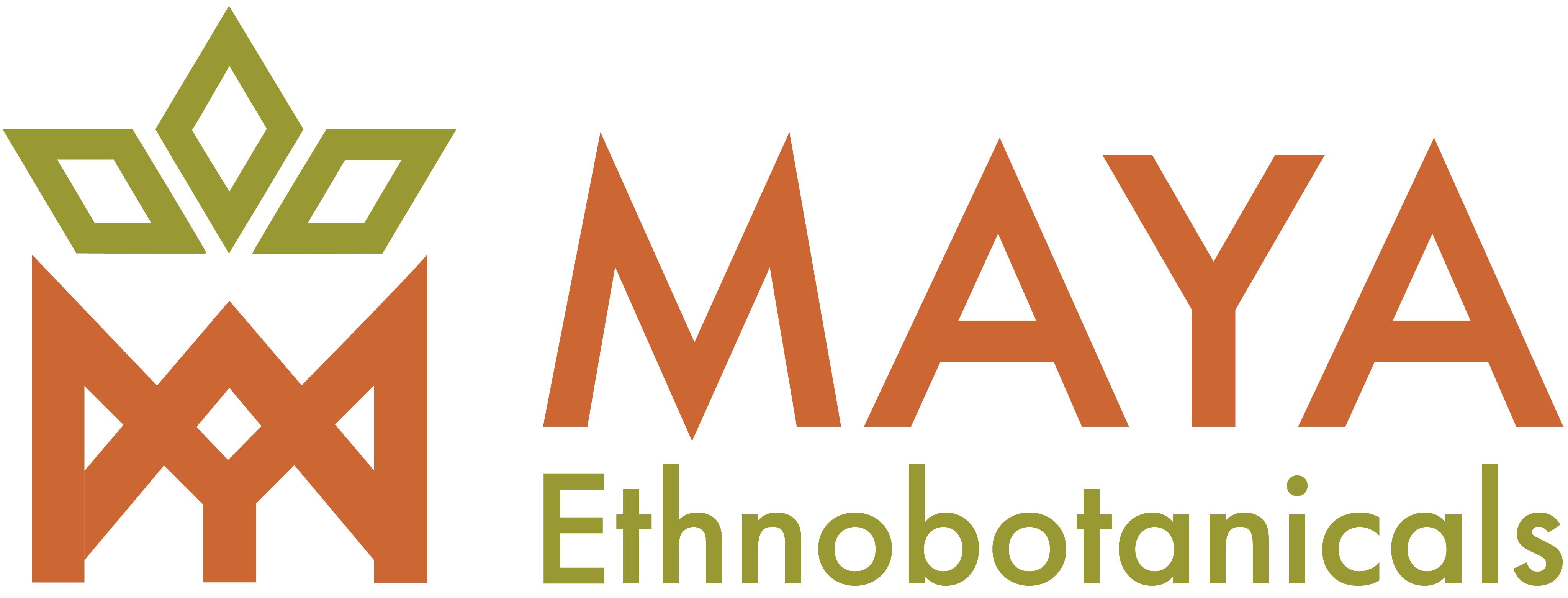

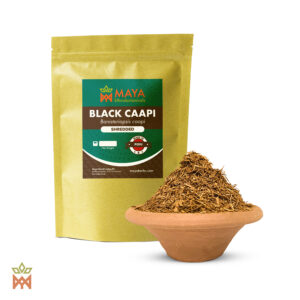

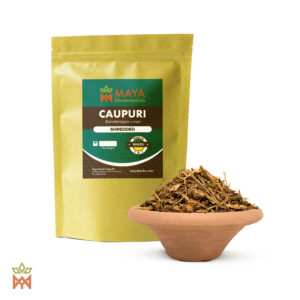
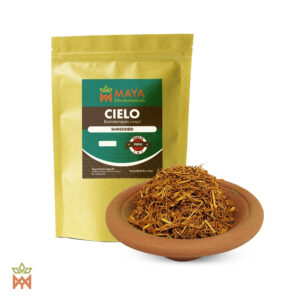
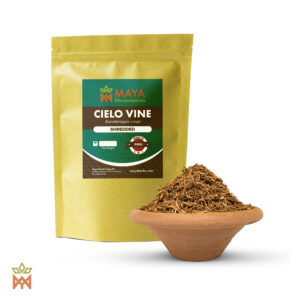
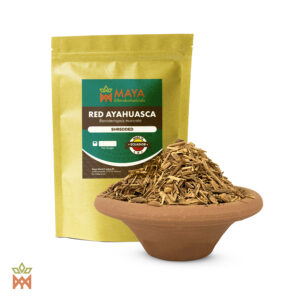
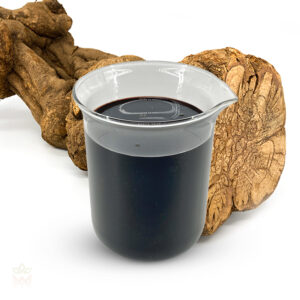
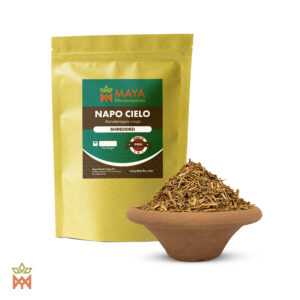
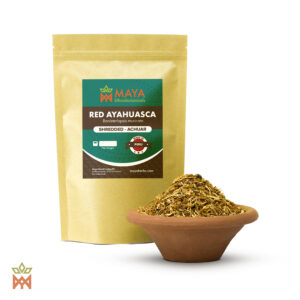
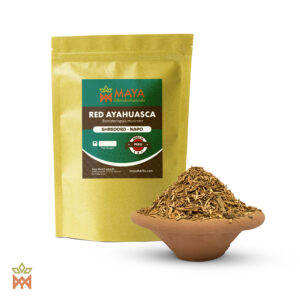
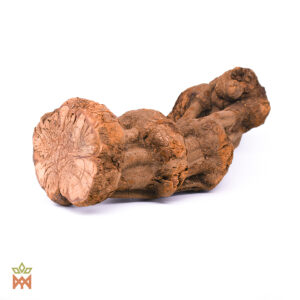
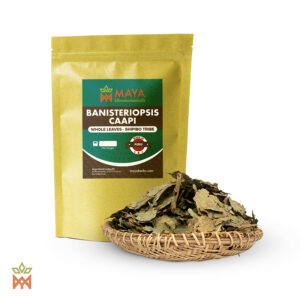
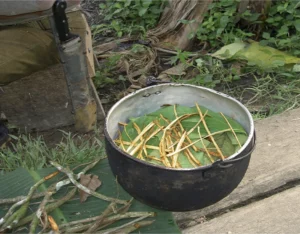 Caapi-only Brews
Caapi-only Brews